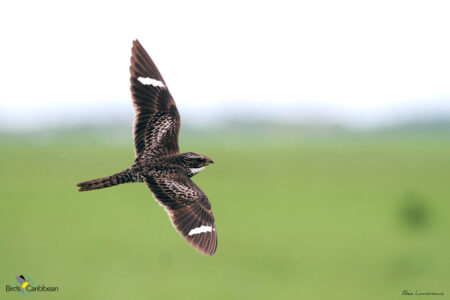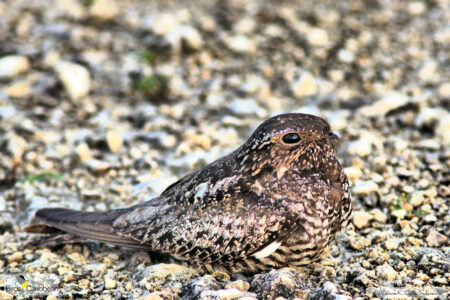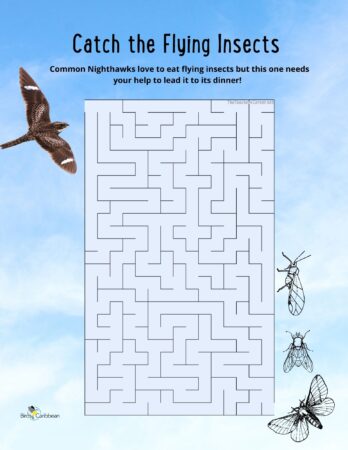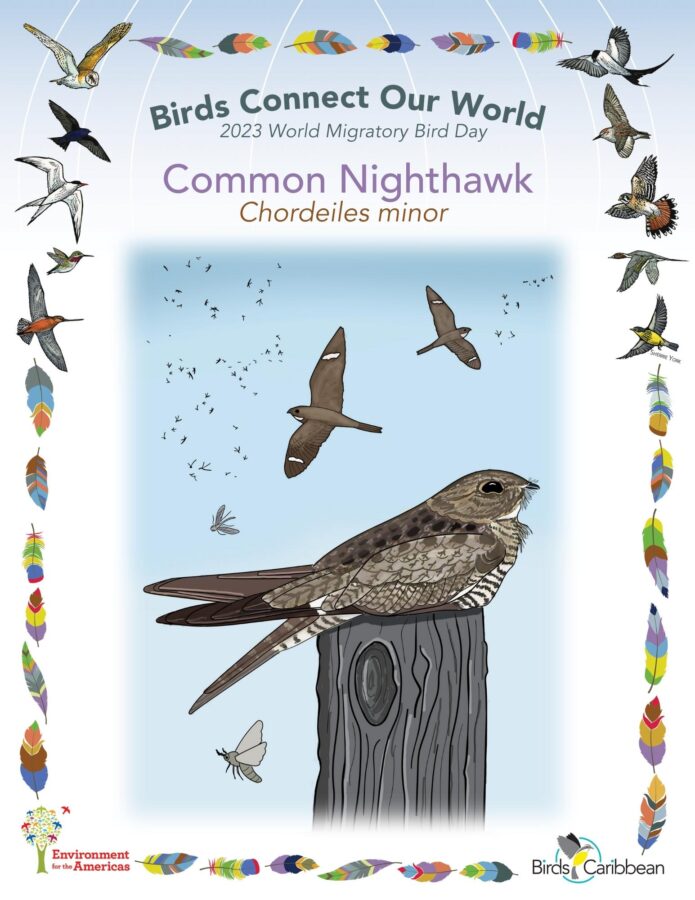Celebrate World Migratory Bird Day (WMBD) with us in 2023! This year’s theme is “Water: Sustaining Bird Life”. Have fun learning about a new migratory bird every day. We have coloring pages, puzzles, activities, and more. Download for free and enjoy nature with your family at home.
Migratory Bird of the Day: Common Nighthawk
Picture yourself on a hot and muggy summer evening, sitting out in the backyard hoping to catch a little breeze that might just keep you from drowning in your own sweat. While you’re sucking down the last drops of grandma’s ice-cold, hand-squeezed lemonade (grandma never disappoints), make an effort to look to the sky. These are the nights when you might get a look at a Common Nighthawk—or hundreds—soaring around above you as they pick off any insects that have drifted up too high.
Nighthawks, like swifts or swallows, are acrobatic flyers that can just as easily catch insects in flight as a baleen whale collects plankton in the ocean. But compared to many other aerial insectivores, nighthawks are large, which works in your favor when you’re looking to spot a few. And the other good news is that you can find them cruising the airways above cities, small towns, suburbia, and well into rural landscapes, so never skip an opportunity to look up and try your luck, wherever you are.
It’s easy to see why nighthawks have been long-standing members of the very exclusive Cool Birds Club. Let’s start with the male’s courtship “booming” behavior. When males are lookin’ for love, they fly up into the sky making a repeated “peent” noise. Then, all of a sudden, they go into a deep dive, accelerating rapidly towards the ground until they reach a point where they abruptly pull their wings forward, creating a “boom” or “whooshing” sound. Ever had your cap go flying off on a windless day? Now you know why.
Another awesome attribute is this species’ camouflage. If they are perched or lying motionless in their nest, human eyes cannot see them. They sport a mottling of very earth-toned colors, including brown, tan, black, and gray, with specklings of white. In fact, these birds blend in so well that there’s probably one looking at you right now and you don’t even know it. However, when these birds are in flight, it’s a different story! They have large scythe-shaped wings, and their dark bodies contrast well with a lighter sky behind them. Look for a very obvious white patch on the underwing to confirm that you are indeed seeing a nighthawk.
It would certainly be nice if the Common Nighthawk was a little more…common. These birds are struggling a bit, and as always, there are some easy things we can collectively do to help these birds become more numerous on our landscapes again. The call to action is as follows:
- Eliminate insecticides from your life, enough said.
- Plant as many and as much diversity of native plants on your landscape as you can (native plants foster higher insect and thus prey abundance).
- Reduce your driving speed—something we should all be doing already in order to protect other wildlife. The roadways out there are a slaughter. Of particular importance is reducing your speed in the evenings and at night, especially on gravel or dirt roads. Nighthawks have been known to roost (i.e. rest/sleep) on these roads at night.
Learn more about this species, including its range, photos, and calls here.
Thanks to Justin Proctor for the text and Christine Elder for the lovely illustration!
Color in the Common Nighthawk
Download the Migratory Birds of the Day Coloring Page! Use the picture above and the photos on this page as your guide, or look up pictures of the bird online or in a bird field guide if you have one. Share your colored-in page with us by posting it online and tagging us @BirdsCaribbean #WMBD2023Carib
Listen to the calls of the Common Nighthawk
The call of the Common Nighthawk is a distinctive nasal “neet.” Note however that this bird does not call often when it is migrating.
Puzzles of the Day
Click on the images below to do the puzzle. You can make the puzzle as easy or as hard as you like—for example, 6, 8, or 12 pieces for young children, all the way up to 1,024 pieces for those that are up for a challenge!


Activity of the Day
 FOR KIDS: Common Nighthawks feed on insects like beetles, flies, moths, crickets, and grasshoppers. Almost all the insects they eat are flying insects and Common Nighthawks will swoop through the air to catch them on the wing!
FOR KIDS: Common Nighthawks feed on insects like beetles, flies, moths, crickets, and grasshoppers. Almost all the insects they eat are flying insects and Common Nighthawks will swoop through the air to catch them on the wing!
Can you help this hungry Common Nighthawk find its way through our maze to to grab some tasty insect food? You can find the correct route here.
FOR KIDS AND ADULTS: Enjoy these videos of a Common Nighthawk in the Wild! Don’t forget to look up for these birds! Sometimes they will be resting in trees.
The second video shows what the Common Nighthawk looks like in flight.


